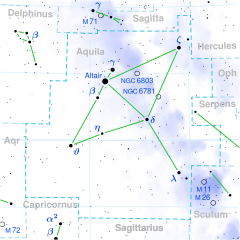
| |
| Observation data Epoch J2000 Equinox J2000 | |
|---|---|
| Constellation | Aquila |
| Right ascension | 19 39 11.64246 |
| Declination | +05° 23′ 51.9797″ |
| Apparent magnitude (V) | +5.17 |
| Characteristics | |
| Spectral type | B3 V + B3 V: |
| U−B color index | −0.60 |
| B−V color index | +0.03 |
| Variable type | β Lyr |
| Astrometry | |
| Radial velocity (Rv) | −4.8 km/s |
| Proper motion (μ) | RA: +3.97 mas/yr Dec.: −4.26 mas/yr |
| Parallax (π) | 4.18 ± 0.40 mas |
| Distance | 780 ± 70 ly (240 ± 20 pc) |
| Absolute magnitude (MV) | −1.69 |
| Orbit | |
| Primary | σ Aql A |
| Companion | σ Aql B |
| Period (P) | 1.95022±0.0001 d |
| Eccentricity (e) | 0 |
| Periastron epoch (T) | 2420054.331±0.0031 JD |
| Semi-amplitude (K1) (primary) | 163.52±1.35 km/s |
| Semi-amplitude (K2) (secondary) | 199±4.1 km/s |
| Details | |
| σ Aql A | |
| Mass | 6.8±0.1 M☉ |
| Radius | 4.22±0.06 R☉ |
| Luminosity | 1,862 L☉ |
| Temperature | 18,493 K |
| Rotational velocity (v sin i) | 36.1±8.9 km/s |
| Age | 140 Myr |
| σ Aql B | |
| Mass | 5.4±0.1 M☉ |
| Radius | 3.05±0.11 R☉ |
| Luminosity | 524 L☉ |
| Temperature | 15,848 K |
| Rotational velocity (v sin i) | 120 km/s |
| Other designations | |
| σ Aql, 44 Aquilae, BD+05 4225, HD 185507, HIP 96665, HR 7474, SAO 124903. | |
| Database references | |
| SIMBAD | data |
Sigma Aquilae, Latinized from σ Aquilae, is the Bayer designation for a binary star system in the equatorial constellation of Aquila. The baseline apparent magnitude of the pair is +5.17, which, according to the Bortle Dark-Sky Scale, is bright enough to be seen with the naked eye from suburban skies. Because of the Earth's orbit about the Sun, this system has an annual parallax shift of 4.18 mas. This provides a distance estimate of approximately 780 light-years (240 parsecs).

Sigma Aquilae is a double-lined spectroscopic binary system consisting of two massive B-type main sequence stars; each has a stellar classification of B3 V. They are detached components, which means the two stars are sufficiently distant from each other that neither fills its Roche lobe.
Because the orbital plane lies close to the line of sight with the Earth, they form an eclipsing binary system. The two components are each distorted by the gravity of the other star, and their shapes mean that the magnitude of the star system varies constantly even outside of the eclipses, an arrangement known as a Beta Lyrae variable. The brightness of the pair decreases during each eclipse, which occurs with a frequency determined by their orbital period of 1.95026 days. During the eclipse of the primary component the net magnitude decreases by 0.20 to 5.37; the eclipse of the secondary component results in a magnitude decrease of 0.10 to 5.27.
References
- ^ van Leeuwen, F. (November 2007), "Validation of the new Hipparcos reduction", Astronomy and Astrophysics, 474 (2): 653–664, arXiv:0708.1752, Bibcode:2007A&A...474..653V, doi:10.1051/0004-6361:20078357, S2CID 18759600.
- ^ Nicolet, B. (1978), "Photoelectric photometric Catalogue of homogeneous measurements in the UBV System", Astronomy and Astrophysics Supplement Series, 34: 1–49, Bibcode:1978A&AS...34....1N.
- ^ Levato, H. (January 1975), "Rotational velocities and spectral types for a sample of binary systems", Astronomy and Astrophysics Supplement Series, 19: 91–99, Bibcode:1975A&AS...19...91L.
- ^ Lefèvre, L.; et al. (November 2009), "A systematic study of variability among OB-stars based on HIPPARCOS photometry", Astronomy and Astrophysics, 507 (2): 1141–1201, Bibcode:2009A&A...507.1141L, doi:10.1051/0004-6361/200912304.
- Wilson, Ralph Elmer (1953), "General catalogue of stellar radial velocities", Carnegie Institute Washington D.C. Publication, Carnegie Institution of Washington, Bibcode:1953GCRV..C......0W.
- Anderson, E.; Francis, Ch. (2012), "XHIP: An extended hipparcos compilation", Astronomy Letters, 38 (5): 331, arXiv:1108.4971, Bibcode:2012AstL...38..331A, doi:10.1134/S1063773712050015, S2CID 119257644.
- Jordan, Frank Craig (1916), "The orbit and spectrum of Aquilae", Publications of the Allegheny Observatory of the University of Pittsburgh, 3 (22): 189–196, Bibcode:1916PAllO...3..189J.
- ^ Malkov, O. Yu. (December 2007), "Mass-luminosity relation of intermediate-mass stars", Monthly Notices of the Royal Astronomical Society, 382 (3): 1073–1086, Bibcode:2007MNRAS.382.1073M, doi:10.1111/j.1365-2966.2007.12086.x.
- Tetzlaff, N.; Neuhäuser, R.; Hohle, M. M. (January 2011), "A catalogue of young runaway Hipparcos stars within 3 kpc from the Sun", Monthly Notices of the Royal Astronomical Society, 410 (1): 190–200, arXiv:1007.4883, Bibcode:2011MNRAS.410..190T, doi:10.1111/j.1365-2966.2010.17434.x, S2CID 118629873.
- ^ Pan, Kaike; Tan, Huisong; Shan, Hongguang (July 1998), "Orbital circularization in detached binaries with early-type primaries", Astronomy and Astrophysics, 335: 179–182, Bibcode:1998A&A...335..179P.
- "* sig Aql", SIMBAD, Centre de données astronomiques de Strasbourg, retrieved 2012-07-20.
- "Light Curve", Hipparcos ESA, ESA, retrieved 17 February 2022.
- van Rensbergen, W.; De Loore, C.; Jansen, K. (February 2006), "Evolution of interacting binaries with a B type primary at birth", Astronomy and Astrophysics, 446 (3): 1071–1079, Bibcode:2006A&A...446.1071V, doi:10.1051/0004-6361:20053543.
- Zasche, P.; et al. (August 2009), "A Catalog of Visual Double and Multiple Stars With Eclipsing Components", The Astronomical Journal, 138 (2): 664–679, arXiv:0907.5172, Bibcode:2009AJ....138..664Z, doi:10.1088/0004-6256/138/2/664, S2CID 17089387.
External links
| Constellation of Aquila | |||||||||||||
|---|---|---|---|---|---|---|---|---|---|---|---|---|---|
| Stars |
| ||||||||||||
| |||||||||||||
| |||||||||||||
| Nebulae |
| ||||||||||||
| Galaxies |
| ||||||||||||